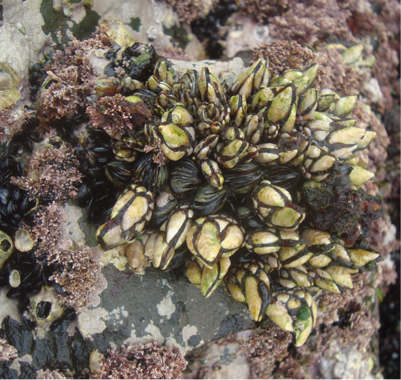Akilah T.M. et al 2014. Evaluation of Stakeholder Perspectives on the Management of the Stalked barnacles (Pollicipes pollicipes) Resource in the Parque Natural do Sudoeste Alentejano e Costa Vicentina, Portugal
Albuquerque R. 2014. Elemental microchemistry, fatty acid profile and geometric morphometrics signatures of goose barnacles (Pollicipes pollicipes) reveal their place of origin.
Barnes M. 1996. Pedunculate cirripedes of the genus Pollicipes
Bidegain G. et al 2015. Assessing the suitability of the minimum capture size and protection regimes in the gooseneck barnacle shellfishery
Borja A. et al 2006. Relationships between wave exposure and biomass of the goose barnacle (Pollicipes pollicipes, Gmelin, 1790) in the Gaztelugatxe Marine Reserve (Basque Country, northern Spain)
Castro J. 2004. Predação humana no litoral rochoso alentejano: caracterização, impacte ecológico e conservação
Cruz T. 2000. Biologia e Ecologia do Percebe Pollicipes pollicipes (Gmelin, 1790), no litoral sudoeste Português
Cruz T. and Araújo J. 1999. Reproductive patterns of Pollicipes pollicipes (Cirripedia: Scalpellomorpha) on the southwestern coast of Portugal
Cruz T. and Hawkins S. 1998. Reproductive cycle of Pollicipes pollicipes at Cabo de Sines, south-west coast of Portugal
Cruz T., Castro J. and Hawkins S. 2010. Recruitment, growth and population size structure of Pollicipes pollicipes in SW Portugal
Jacinto D. et al 2010. Stalked barnacle (Pollicipes pollicipes) harvesting in the Berlengas Nature Reserve, Portugal: temporal variation and validation of logbook data
Jacinto D. et al 2011. Management of the stalked barnacle (Pollicipes pollicipes) fishery in the Berlengas Nature Reserve (Portugal): evaluation of bag and size limit regulation measures.
Jacinto D. et al 2015. Growth rate variation of the stalked barnacle Pollicipes pollicipes (Crustacea: Cirripedia) using calcein as a chemical marker.
Jesus D. 2003. Gestão do Percebe no Parque Natural do Sudoeste Alentejano e Costa Vicentina
Molares J. et al 1994. Larval development of the pedunculate barnacle Pollicipes cornucopia (Cirripedia: Scalpellomorpha) reared in the laboratory
Molares J. and Freire J. 2003. Development and perspectives for community-based management of the goose barnacle (Pollicipes pollicipes) fisheries in Galicia (NW Spain)
Parada, J. M. et al 2012. Assessment of goose barnacle (Pollicipes pollicipes Gmelin, 1789) stocks in management plans: design of a sampling program based on the harvesters’ experience
Reis, P. et al 2013. Seasonal variation of metal contamination in the barnacles Pollicipes pollicipes in northwest coast of Portugal show clear correlation with levels in the surrounding water.
Rivera A. et al 2013. Role of Upwelling on Larval Dispersal and Productivity of Gooseneck Barnacle Populations in the Cantabrian Sea: Management Implications
Rivera A. et al 2014. Co-management in Europe: Insights from the gooseneck barnacle fishery in Asturias, Spain
Sousa A. 2007. Distribuição e abundância do percebe, Pollicipes pollicipes (Gmelin, 1790) na Reserva Natural das Berlengas: relação com o hidrodinamismo e efeitos da predação
Sousa A. et al 2013. Patterns of distribution and abundance of the stalked barnacle (Pollicipes pollicipes) in the central and southwest coast of continental Portugal
Vázquez-Rowe A. et al 2013. Carbon footprint analysis of goose barnacle (Pollicipes pollicipes) collection on the Galician coast (NW Spain)





